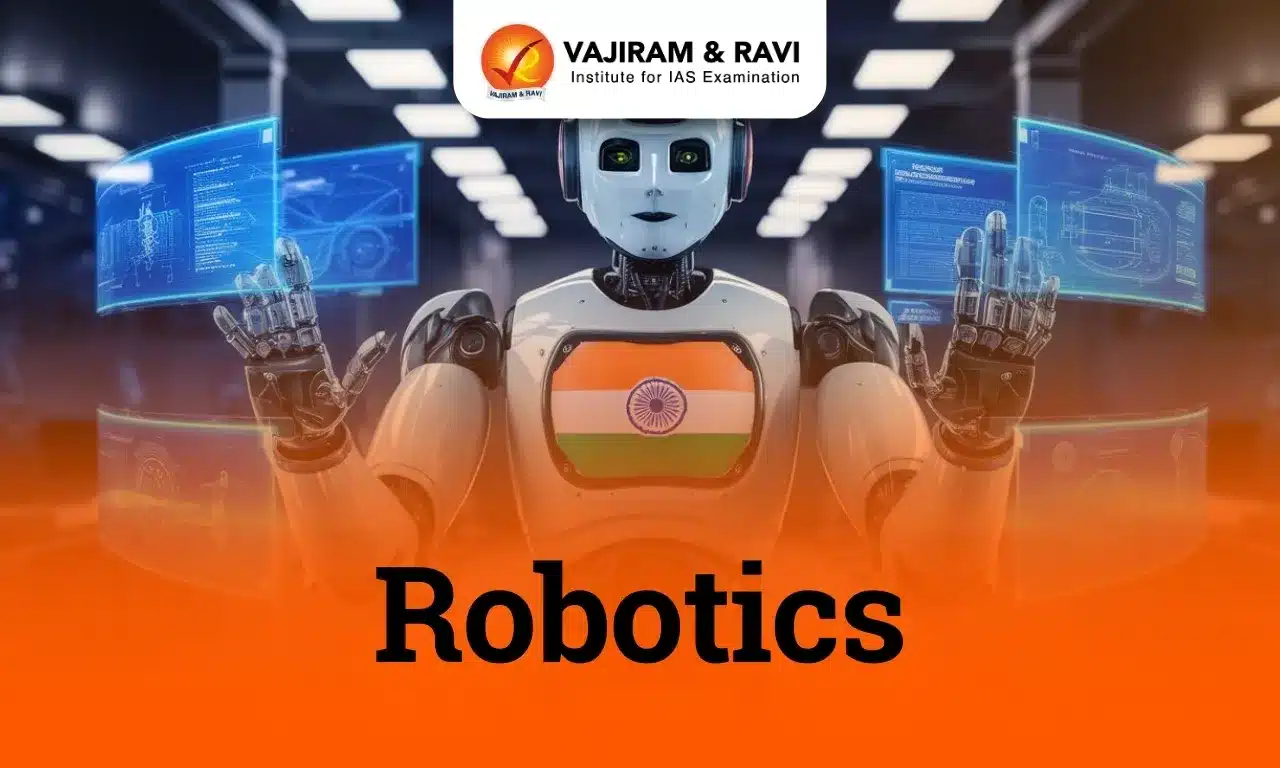Robotics is the application of science, engineering, and technology to the design, build and usage of machines that are programmed to mimic, replace and help humans. Robots are becoming increasingly prevalent in various industries, including manufacturing, healthcare, agriculture, and logistics.
In the 21st century, the field of robotics and research into the potential uses and functionality of robots has grown significantly. Robotics in India is in nascent stages and to create large-scale socio-economic impact, it requires concerted as well as collaborative interventions.
Robotics
Robotics is the design, construction, and application of machines (robots) to perform tasks traditionally performed by humans.
- Robots are widely used in industries such as automobile manufacturing to perform simple repetitive tasks and in industries where work must be performed in environments hazardous to humans.
- Many aspects of robotics involve artificial intelligence; robots may be equipped with human-like senses, such as vision, touch, and temperature sensing.
Background of Robotics
During the Industrial Revolution and the Age of Enlightenment, an increased focus on engineering, mathematics, and science grew in England, boosting the momentum toward the implementation of robotics in society.
- In the 1930s, the popularity of computers fueled the development of Numerically Controlled (NC) machines, paving the way for industrial robots.
- The first known industrial robot dates back to 1937 when Griffith Taylor built a crane-like device capable of automating the stacking of wooden blocks from pre-programmed patterns.
- In 1954, George Devol known as the ‘Grandfather of Robotics’ awarded with first industrial robotics patent.
- In the 1990s, remote-controlled robots brought synchronisation to the industry.
Laws of Robotics
Isaac Asimov conceptualised the “Three Laws of Robotics,” which were presented in fictional terms to establish an ethical framework for interactions between humans and robots:
- First Law: A robot may not injure a human being, or, through inaction, allow a human being to come to harm.
- Second Law: A robot must obey orders given to it by human beings, except where such orders would conflict with the First Law.
- Third Law: A robot must protect its existence as long as such protection does not conflict with the First or Second Law.
Components of Robot
Robotics typically involve various components that come together to create a functioning system. Key components of robots include:
- Actuators: They are like a robot’s muscles, converting energy into motion. They’re powered by electricity, hydraulics, or pneumatics, moving the robot’s limbs, wheels, or other parts.
- Sensors: Sensors are the robot’s eyes and ears, giving information about its surroundings. They come in types like light, proximity, and force sensors.
- Power supply: Robots need a power source, like batteries or electricity, to work, depending on the robot type and its tasks.
- Controller: The controller is the robot’s brain, getting input from sensors and sending commands to actuators. It interprets data, makes decisions, and controls movements.
- Structure: The structure gives physical support and protection to the robot’s components. It can be metal, plastic, or composite materials.
- Programming: The brain of the robot includes algorithms, AI, and software for decision-making, movement, and interactions.
- End effectors: These are tools like grippers, welding arms, or sensors, that allow the robot to interact with its environment.
Types of Robots
Robots come in various types, each designed for specific tasks, environments, and functionalities. Some common types of robots include:
- Autonomous Mobile Robots (AMRs): These robots navigate autonomously using sensors, cameras, or laser systems, often employed in logistics for goods transportation in dynamic environments.
- Automated Guided Vehicles (AGVs): While AMRs can freely traverse environments, AGVs rely on tracks or predefined paths and frequently require operator supervision. These are commonly used in controlled environments such as storage facilities and factory floors to deliver materials and move items.
- Articulated robots: Articulated robots (also known as robotic arms) are designed to perform functions similar to those of a human arm. These are typically made up of two to ten rotary joints. With each additional joint or axis, the range of motion increases, making these ideal for arc welding, material handling, machine tending, and packaging.
- Humanoid robots: They resemble human-like features and may mimic human movements and actions. They can be used in research, entertainment, or as companions for the elderly or individuals with disabilities.
- For example, Sophia is considered the most famous and advanced humanoid robot. It also was granted Saudi Arabian citizenship in 2017.
- Collaborative robots (Cobots): Cobots are intended to work alongside or directly with humans. Cobots can share workspaces with humans to help them get more done. They are frequently used to eliminate manual, hazardous, or strenuous tasks from daily workflows.
- YuMi, for example, is a popular cobot from leading robot manufacturer ABB. It is specifically intended for the assembly of small electronic devices.
- Hybrids: The various types of robots are frequently combined to create hybrid solutions capable of performing more complex tasks.
- For example, an AMRs could be combined with a robotic arm to create a package-handling robot in a warehouse.
Status of Robotics in India
India has made multiple strides towards strengthening its industrial base with the adoption of advanced manufacturing technologies such as robotics, enabling productivity gains, in the last decade.
- In the span of five years, i.e., 2016-2021, the operational stock of industrial robots doubled.
- India was globally ranked 10 in terms of annual industrial installations, as per the World Robotics Report, 2022.
- The growth of the robotics ecosystem in India has been slower in comparison to certain developed economies.
Initiatives by the Government
The government of India has established the following research centres regarding the development of robotics in India.
- Artificial Intelligence and Robotics Technology Park (ARTPARK) Technology Innovation Hub under the National Mission on Interdisciplinary Cyber-Physical Systems (NM-ICPS) has been established to leverage AI and robotics.
- Center for Advanced Manufacturing for Robotics and Autonomous Systems (CAMRAS) has been established to reduce the import of robotics and autonomous systems.
- I-HUB Foundation for Cobotics (IHFC), IIT Delhi has launched 8 grand projects in the area of Medical Simulators, Healthcare Robotics, Rehabilitation Robotics, Drone Applications, etc.
- National Strategy for Robotics: The draft strategy aims to position India as a global leader in robotics by 2030 to actualize its transformative potential.
- ISRO and Robotics: For manned missions, ISRO is in the process of developing humanoid robots that can assist and eventually even replace human beings.
- Vyommitra: India is set to launch Vyommitra, a female robot astronaut, into space as part of the ambitious Gaganyaan project in 2024.
- Defence Research & Development Organisation (DRDO)
- Research & Development Establishment (Engineers) is working on the development of robotic platforms for defence applications.
- Combat Vehicles Research and Development Establishment (CVRDE) and VRDE are involved in the development of unmanned tracked and wheeled vehicles.
- The Centre for Artificial Intelligence and Robotics (CAIR) is working in the field of autonomous navigation, computer vision processing, and artificial intelligence, for the realisation of autonomous robotic and unmanned systems.
- Capacity Building Initiatives
- FutureSkills Prime (MeitY): Under this, a robust online platform has been created that aims to offer subsidised access to certified courses to interested participants in AI, Blockchain, Robotics, Cybersecurity, etc.
- Atal Innovation Mission: ATLs have dedicated innovation workspaces where Do-It-Yourself (DIY) kits on emerging technologies like robotics, IoT, etc. have been installed.
- e-YANTRA: Robotics outreach program funded by the Ministry of Education to harness the talent of young engineers to solve problems in agriculture, manufacturing, defence, etc.
Make-in-India Robots
- DAKSHA: An automated mobile platform for multi-purpose payloads.
- It has stair-climbing capabilities and can be deployed for handling IEDs (Improvised Explosive Devices).
- Vyommitra: A spacefaring humanoid robot is being developed by the ISRO to function onboard the Gaganyaan.
- MANAV: India’s first 3D-printed humanoid robot with inbuilt vision and sound processing capability which allows it to walk, talk and dance just in response to human commands.
Applications of Robotics
Robotics finds applications in various fields, and its versatility allows it to be used in numerous industries.
- Manufacturing and assembly: Robots are widely used in automotive assembly lines for welding, painting, pick-and-place tasks, and quality control.
- Healthcare: Robots aid surgeons in surgeries, ensuring faster recovery. Robotic exoskeletons assist rehabilitation and help patients regain mobility post-injury. Telemedicine robots enable remote consultations, crucial in areas with limited medical access.
- For example: Toyota’s healthcare assistants are an example of robots aiding in walking rehabilitation.
- Logistics: Warehouse robots manage inventory, sorting, and packaging, optimising efficiency. Autonomous Mobile Robots (AMRs) navigate warehouses, enhancing productivity.
- Agriculture: Agricultural robots assist in planting, harvesting, and monitoring crops, promoting precision farming. Autonomous tractors aid in planting and harvesting, while agricultural drones survey fields for crop health assessment.
- Retail and hospitality: Robotics enhance customer experience by automating inventory processes, providing wayfinding services, and assisting with baggage or parking valet services in the retail and hospitality sectors.
- Education: Robots facilitate hands-on learning experiences and engage students in STEM subjects.
- For example:Softbank Robotics developed the Nao model for the L2TOR European research project, teaching young children a second language.
- Space exploration: Robotics technology is essential to space exploration because it allows for the exploration of asteroids, moons, and other planets.
- Rovers like NASA’s Curiosity explore planetary surfaces, collecting data and samples.
- Defence and security: Military and security applications feature bomb disposal robots, surveillance drones, and unmanned vehicles for reconnaissance in hazardous zones.
- Smart cities: Robotics enhance urban safety and efficiency.
- Humanoid robots offer navigation and information services.
- AMRs deliver goods and conduct routine security patrols.
- Robotics expedite building construction by conducting site surveys and collecting building modelling data.
Challenges Associated with Robotics
Despite the tremendous advancements in robotics, there are still significant challenges that need to be addressed to ensure the safe and reliable deployment of robots in real-world applications.
- Safety concerns: Industrial robot accidents can be fatal. Better safety protocols and human-robot collaboration methods are crucial. In 2015, a worker at a Volkswagen factory in Germany was allegedly killed by a robot.
- Ethical concerns: AI-powered robots raise ethical questions, such as autonomous weapons and algorithmic biases. Issues in healthcare and law enforcement ethics are significant.
- Cybersecurity risks: Increased connectivity makes robots vulnerable to cyber-attacks. In 2017, the “WannaCry”ransomware attack affected a US robot manufacturing facility.
- Data and algorithm bias: Robots trained on large datasets may perpetuate societal biases. For example, Amazon’s facial recognition software showed bias in gender identification in 2019.
- Job loss: Automation in industries leads to job displacement. In manufacturing, robots have caused job losses, creating socio-economic challenges. Goldman Sachs estimates 300 million jobs could be lost or diminished by this fast-growing technology.
- Cost and accessibility: High development costs limit robotics accessibility, especially in smaller industries or developing regions.
- Regulatory frameworks: Lack of standardised regulations raises concerns about safety, liability, and ethical use. Clear guidelines for robotic system development and deployment are crucial.
Last updated on July, 2025
→ UPSC Notification 2025 was released on 22nd January 2025.
→ UPSC Prelims Result 2025 is out now for the CSE held on 25 May 2025.
→ UPSC Prelims Question Paper 2025 and Unofficial Prelims Answer Key 2025 are available now.
→ UPSC Calendar 2026 is released on 15th May, 2025.
→ The UPSC Vacancy 2025 were released 1129, out of which 979 were for UPSC CSE and remaining 150 are for UPSC IFoS.
→ UPSC Mains 2025 will be conducted on 22nd August 2025.
→ UPSC Prelims 2026 will be conducted on 24th May, 2026 & UPSC Mains 2026 will be conducted on 21st August 2026.
→ The UPSC Selection Process is of 3 stages-Prelims, Mains and Interview.
→ UPSC Result 2024 is released with latest UPSC Marksheet 2024. Check Now!
→ UPSC Toppers List 2024 is released now. Shakti Dubey is UPSC AIR 1 2024 Topper.
→ Also check Best IAS Coaching in Delhi















